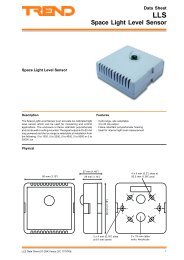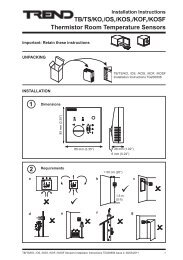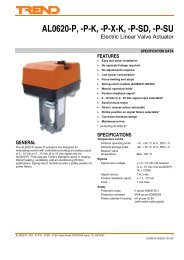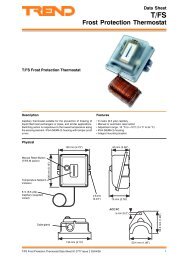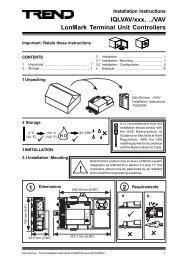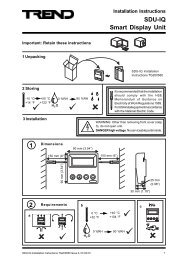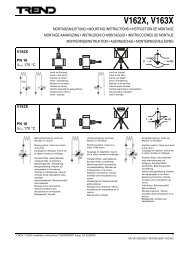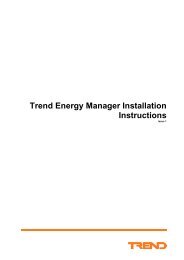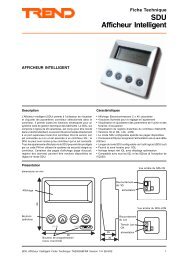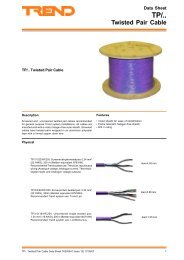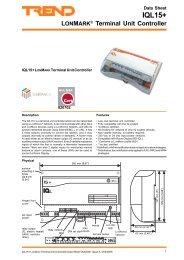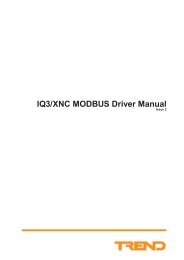TW/.., PCW/.., XW/R/IQ Wireless Sensors and Receiver Data ... - Trend
TW/.., PCW/.., XW/R/IQ Wireless Sensors and Receiver Data ... - Trend
TW/.., PCW/.., XW/R/IQ Wireless Sensors and Receiver Data ... - Trend
You also want an ePaper? Increase the reach of your titles
YUMPU automatically turns print PDFs into web optimized ePapers that Google loves.
100-240 V<br />
OK<br />
RX<br />
<strong>TW</strong>/.., <strong>PCW</strong>/.., <strong>XW</strong>/R/<strong>IQ</strong><br />
<strong>Data</strong> Sheet<br />
FUNCTIONALITY (continued)<br />
Reception<br />
The recommended maximum range between a wireless sensor<br />
<strong>and</strong> the <strong>XW</strong>/R/<strong>IQ</strong> receiver is 75 metres (80 yds).<br />
All sensors transmit on the same frequency b<strong>and</strong> (433.05 to<br />
434.79 MHz).<br />
Propagation<br />
The signal propagation within the building also depends on :<br />
Reflection from flat surfaces such as metal cladding,<br />
galvanized roofing, foil backed plaster board.<br />
Radiation from thin conductors such a pipe work, electrical<br />
wiring, steel.<br />
Reflection <strong>and</strong> re-transmission can result in a st<strong>and</strong>ing<br />
wave being set up in the area. If the receiver happens<br />
to be in a null of the wave, moving its position slightly will<br />
result in stronger reception.<br />
Absorption by lossy materials such as damp concrete,<br />
stone work, <strong>and</strong> people. High RF barriers are paper (e.g.<br />
books), concrete (floors, outer walls), <strong>and</strong> metal<br />
(elevator shafts, cabinets).<br />
Generally, the higher the transmitter is mounted, the further the<br />
signal will reach. It is recommended to mount the transmitter<br />
above partition height if possible.<br />
Interference<br />
It is not recommended that other equipment operating over the<br />
same frequency b<strong>and</strong> be used in the same environment (e.g.<br />
amateur radio). It is also advisable to keep the wireless sensors<br />
<strong>and</strong> <strong>XW</strong>/R/<strong>IQ</strong> away from other sources of interference e.g.<br />
computer (>1 m, 1 yds), microwave ovens, switch mode power<br />
supplies.<br />
ACC/RW/<strong>IQ</strong> Repeater<br />
The repeater can be used to increase the maximum distance<br />
between a transmitter <strong>and</strong> the receiver. Thus, if the repeater is<br />
placed within 75 metres (80 yds) of the transmitter, the receiver<br />
can then be 75 metres (80 yds) from the repeater which increases<br />
the total distance from the transmitter to the receiver to 150 metres<br />
(160 yds).<br />
In a white walled building (a building with rooms thermally insulated<br />
with foam <strong>and</strong> aluminium sheets; food industry) best performance<br />
may be found by mounting the repeater in the loft space above<br />
the white walled area. There will always be a degree of leakage<br />
in a white walled building, <strong>and</strong> propagation is much easier out<br />
of the room, in a loft space, compared to between white walls.<br />
Enclosure: The repeater is supplied in a compact diecast<br />
wall mounting enclosure.The bracket supplied should be<br />
used to secure the unit to a wall such that the antenna<br />
is vertically polarised.<br />
Input Power: The repeater requires 230 Vac 50 Hz at<br />



